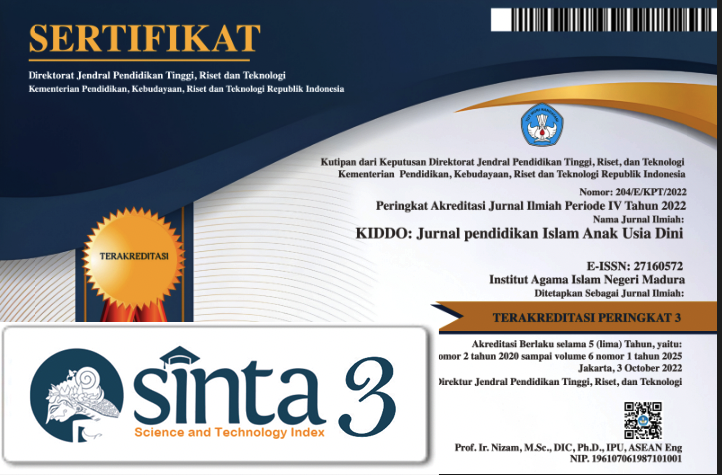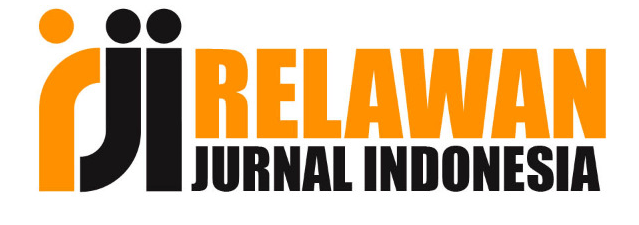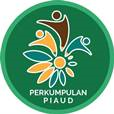Harmonizing Child-Friendly Early Childhood Education: The Impact of Gamelan Music on Focus and Attention in Child-Centric Learning Environments
 Abstract views: 366
,
Abstract views: 366
,
 PDF downloads: 318
PDF downloads: 318
Abstract
Focus and attention are very important abilities for children to train because they will affect various aspects of their future lives This study aims to explore the influence of gamelan music on young children's focus during cutting and pasting activities. Using the experimental method, the number of participants was 30 children (12 boys and 18 girls) with a mean age of 5.54 years (SD: 0.50). The research subjects were divided into two groups, namely the experimental group who were given galeman music and the control group who were not given. . The results of the study showed that children who were given gamelan music while carrying out these activities tended to have lower levels of concentration. These findings highlight the importance of paying attention to the auditory environment when designing early childhood learning experiences. Gamelan music, with its distinctive sound characteristics, can be a distractor that affects a child's ability to focus on a given task. Therefore, the recommendation to carefully select the type of music played in the background in early childhood learning activities is necessary to support their cognitive development optimally.
Downloads
References
Bugos, J. A., & DeMarie, D. (2017). The effects of a short-term music program on preschool children’s executive functions. Psychology of Music, 45(6), 855–867. https://doi.org/10.1177/0305735617692666
Diamond, A. (2020). Executive functions. Dalam Handbook of Clinical Neurology (Vol. 173, hlm. 225–240). Elsevier. https://doi.org/10.1016/B978-0-444-64150-2.00020-4
El Boghdady, M., & Ewalds-Kvist, B. M. (2020). The influence of music on the surgical task performance: A systematic review. International Journal of Surgery, 73, 101–112. https://doi.org/10.1016/j.ijsu.2019.11.012
Fitriani, D. N., Cahyani, F., & Baqi, S. A. (2022). Implementasi Pembelajaran Auditori Melalui Aktivitas Musik Barang Bekas Untuk Meningkatkan Kognitif Anak Usia. Prosiding SEMDIKJAR 5.
Gallen, C. L., Schaerlaeken, S., Younger, J. W., Project iLEAD Consortium, Younger, J. W., O’Laughlin, K. D., Anguera, J. A., Bunge, S. A., Ferrer, E. E., Hoeft, F., McCandliss, B. D., Mishra, J., Rosenberg-Lee, M., Gazzaley, A., Uncapher, M. R., Anguera, J. A., & Gazzaley, A. (2023). Contribution of sustained attention abilities to real-world academic skills in children. Scientific Reports, 13(1), 2673. https://doi.org/10.1038/s41598-023-29427-w
Goltz, F., & Sadakata, M. (2021). Do you listen to music while studying? A portrait of how people use music to optimize their cognitive performance. Acta Psychologica, 220, 103417. https://doi.org/10.1016/j.actpsy.2021.103417
Habibi, A., Cahn, B. R., Damasio, A., & Damasio, H. (2016). Neural correlates of accelerated auditory processing in children engaged in music training. Developmental Cognitive Neuroscience, 21, 1–14. https://doi.org/10.1016/j.dcn.2016.04.003
Hallam, S. (2010). The power of music: Its impact on the intellectual, social and personal development of children and young people. International Journal of Music Education, 28(3), 269–289. https://doi.org/10.1177/0255761410370658
Hastjarjo, T. D. (2014). Rancangan Eksperimen Acak. Buletin Psikologi, 22(2), 73. https://doi.org/10.22146/bpsi.11455
Heaton, S. C., Reader, S. K., Preston, A. S., Fennell, E. B., Puyana, O. E., Gill, N., & Johnson, J. H. (2001). The Test of Everyday Attention for Children (TEA-Ch): Patterns of Performance in Children With ADHD and Clinical Controls. Child Neuropsychology, 7(4), 251–264. https://doi.org/10.1076/chin.7.4.251.8736
Hirsh-Pasek, K., Zosh, J. M., Golinkoff, R. M., Gray, J. H., Robb, M. B., & Kaufman, J. (2015). Putting Education in “Educational” Apps: Lessons From the Science of Learning. Psychological Science in the Public Interest, 16(1), 3–34. https://doi.org/10.1177/1529100615569721
Jones, P. R., Moore, D. R., & Amitay, S. (2015). Development of auditory selective attention: Why children struggle to hear in noisy environments. Developmental Psychology, 51(3), 353–369. https://doi.org/10.1037/a0038570
Kholidah, N. D. (2023). Perkembangan Gamelan Jawa di Nusantara. Maliki Interdisciplinary Journal, 1(2), 165–176.
Kirby, A. L., Dahbi, M., Surrain, S., Rowe, M. L., & Luk, G. (2023). Music Uses in Preschool Classrooms in the U.S.: A Multiple-Methods Study. Early Childhood Education Journal, 51(3), 515–529. https://doi.org/10.1007/s10643-022-01309-2
Korom, M., Callaghan, B. L., VanTieghem, M., Silvers, J. A., Choy, T., Kalter, J., Blumenthal, E., & Tottenham, N. (2022). Shifting children’s attentional focus to emotions during art museum experiences. British Journal of Developmental Psychology, 40(1), 73–91. https://doi.org/10.1111/bjdp.12390
Kristanto, A. (2022). Penggunaan Gamelan dalam Perspektif Pendidikan Seni di Era 4.0. Clef : Jurnal Musik dan Pendidikan Musik, 3(2), 78–86. https://doi.org/10.51667/cjmpm.v3i2.1073
Lillard, A. S., Lerner, M. D., Hopkins, E. J., Dore, R. A., Smith, E. D., & Palmquist, C. M. (2013). The impact of pretend play on children’s development: A review of the evidence. Psychological Bulletin, 139(1), 1–34. https://doi.org/10.1037/a0029321
Litovsky, R. (2015). Development of the auditory system. Dalam Handbook of Clinical Neurology (Vol. 129, hlm. 55–72). Elsevier. https://doi.org/10.1016/B978-0-444-62630-1.00003-2
Mendes, C. G., Diniz, L. A., & Marques Miranda, D. (2021). Does Music Listening Affect Attention? A Literature Review. Developmental Neuropsychology, 46(3), 192–212. https://doi.org/10.1080/87565641.2021.1905816
Rickard, N. S., Vasquez, J. T., Murphy, F., Gill, A., & Toukhsati, S. R. (2010). instrumental music program on verbal memory of primary school children: A longitudinal study. 1.
Riskiyanto, A., & Asnawi, M. F. (2023). Aplikasi Pengenalan dan Pembelajaran Alat Musik Tradisional Gamelan Jawa Berbasis Agung 1,. NUansa : Jurnal Penelitian, Pengabdian Dan Kajian Keislaman, 1(2), 82–89.
Sanjaya, A. K. (2022). Pemanfaatan Saron Sanga Laras Slendro Gamelan Jawa Sebagai Media Pembelajaran Fisika SMA Materi Gelombang Bunyi. SCIENCE : Jurnal Inovasi Pendidikan Matematika dan IPA, 2(2), 183–193. https://doi.org/10.51878/science.v2i2.1263
Siregar, F. S., Almawaddah, N., & Panjaitan, M. F. R. (2023). Implementasi Penggunaan Hipotesis Komparatif dalam Penelitian Pendidikan. Al Ittihadu, 3(1).
Thompson, W. F., Schellenberg, E. G., & Husain, G. (2003). Perceiving Prosody in Speech: Effects of Music Lessons. Annals of the New York Academy of Sciences, 999(1), 530–532. https://doi.org/10.1196/annals.1284.067
Trappe, H. J. (2012). Trappe, H. J. (2012). The effect of music on human physiology and pathophysiology. , 4(2), 100-105. Music and medicine, 4(2), 100–105. https://doi.org/10.3233/WOR-2011-1141
Welch, G. F., Biasutti, M., MacRitchie, J., McPherson, G. E., & Himonides, E. (2020). The Impact of Music on Human Development and Well-Being. Frontiers in Psychology, 11, 1246. https://doi.org/10.3389/fpsyg.2020.01246
Copyright (c) 2024 Safiruddin Al Baqi, Ratna Nila Puspitasari

This work is licensed under a Creative Commons Attribution 4.0 International License.
-
The journal operates an Open Access policy under a Creative Commons 4.0 International license. The terms of the license are:
Share— copy and redistribute the material in any medium or format
Adapt— remix, transform, and build upon the material for any purpose, even commercially.
1. Authors retain copyright and grant the journal right of first publication with the work simultaneously licensed under a Creative Commons License.that allows others to share the work with an acknowledgement of the work’s authorship and initial publication in this journal
2. Authors are permitted and encouraged to post their work online (e.g., in institutional repositories or on their website) prior to and during the submission process, as it can lead to productive exchanges, as well as earlier and greater citation of published work (See The Effect of Open Access).
Jurnal Kiddo is licensed under a Creative Commons
n Access).














